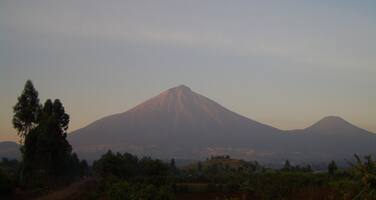Bwindi Impenetrable National Park
Factors affecting the property in 2000*
- Civil unrest
- Human resources
- Illegal activities
Factors* affecting the property identified in previous reports
- Depletion of the population of mountain gorillas
- Security threats
- Urgent need to train park staff
International Assistance: requests for the property until 2000
Total amount approved : 0 USD
Missions to the property until 2000**
Information presented to the Bureau of the World Heritage Committee in 2000
Previous deliberations:
Twenty-third session of the Committee – pages 92/93 as part of Annex VIII.
Twenty-third ordinary session of the Bureau – paragraph IV. 41
New information: IUCN has informed the Centre that since the conclusion of the twenty-third session of the Committee (Marrakesh, 1999) the following information has been received:
- Park management has continued to be strengthened by equipping Park Warden and rangers with additional facilities;
- Combined security force comprising the Park Staff and Uganda Peoples Defence Force has been consolidated;
- Road network to Bwindi and within the surrounding area has been improved;
- Publicity on the improving security situation in the Park for visitors received a tremendous boost from the visit of His Excellency the President of Uganda in late February 2000;
- The number of visitors /tourists has steadily increased to over 200 visitors per month; and
- The Uganda Tourism Board, the Ministry of Tourism, Trade and Industry, and local travel agents have sustained a publicity campaign about the site.
The Secretariat will commend the State Party for the actions taken to improve the security situation in the area and run a campaign to attract an increasing number of visitors back to the area. The Centre and IUCN will continuously monitor improvements in the protection and management of the area and provide an up-to-date progress report to the twenty-fifth session of the Bureau in 2001.
Action Required
Conservation issues presented to the World Heritage Committee in 2000
The Bureau at its twenty-third extraordinary session requested the Centre and IUCN to verify, with the Ugandan authorities, their needs for support for purchase of vehicles and staff training. The Secretariat has not received any request from the State Party, and no reply has been received to the Centre’s letter dated 10 July 2000 informing the State Party on the decision of the Bureau.
Summary of the interventions
Decisions adopted by the Committee in 2000
24 BUR IV.B.78
State of conservation
The Bureau took note of the information provided in the working document on the state of conservation of the following properties:
NATURAL HERITAGE
Comoe National Park (Côte d’Ivoire)
Caves of the Aggtelek and Slovak Karst (Hungary/Slovakia)
The Delegate of Morocco pointed out that the protection of surface water is important in karst systems.
Kaziranga National Park (India)
Lorentz National Park (Indonesia)
Kamchatka Volcanoes (Russian Federation)
Sinharaja Forest Reserve (Sri Lanka)
Bwindi Impenetrable Forest (Uganda)
CULTURAL HERITAGE
Rock-hewn Churches, Lalibela (Ethiopia)
Vilnius Historic Centre (Lithuania)
City of Cuzco (Peru)
Chavin (Archaeological Site) (Peru)
Lines and Geoglyphs of Nasca and Pampas de Jumana (Peru)
24 COM VIII.iii
State of conservation reports of natural properties noted by the Committee
State of conservation reports of natural properties noted by the Committee
Belovezhskaya Pushcha/Bialowieza Forest (Belarus/Poland)
Pirin National Park (Bulgaria)
Dja Faunal Reserve (Cameroon)
Gros Morne National Park (Canada)
Canadian Rocky Mountains Parks (Canada)
Comoe National Park (Côte d'Ivoire)
Galapagos Islands (Ecuador)
Komodo National Park (Indonesia)
Lorenz National Park (Indonesia)
Mount Kenya National Park/Natural Forest (Kenya)
Te Wahipounamu - South West New Zealand (New Zealand)
Arabian Oryx Sanctuary (Oman)
Huascarán National Park (Peru)
Danube Delta (Romania)
Lake Baikal (Russian Federation)
Niokolo-Koba National Park (Senegal)
Doñana National Park (Spain)
Sinharaja Forest Reserve (Sri Lanka)
Bwindi Impenetrable Forest (Uganda)
Gough Island (United Kingdom)
Ngorongoro Conservation Area and the Serengeti National Park (United Republic of Tanzania)
Ha Long Bay (Vietnam)
Mosi-oa-Tunya/Victoria Falls (Zambia/Zimbabwe)
The Bureau may wish to adopt the following decision and transmit it to the Committee for noting:
“The Bureau recalls its earlier request and recommends that the Centre and IUCN continue efforts to verify with the Ugandan authorities on their needs for support for purchase of vehicles and staff training and to continue assisting the Ugandan authorities to obtain financial support from suitable sources, including the World Heritage Fund. The Bureau requests the Centre and IUCN to report on the measures taken to support the management at the twenty-fifth ordinary session of the Bureau in mid-2001.”
* :
The threats indicated are listed in alphabetical order; their order does not constitute a classification according to the importance of their impact on the property.
Furthermore, they are presented irrespective of the type of threat faced by the property, i.e. with specific and proven imminent danger (“ascertained danger”) or with threats which could have deleterious effects on the property’s Outstanding Universal Value (“potential danger”).
** : All mission reports are not always available electronically.


